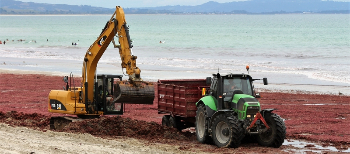
MANGAWHAI'S NO.1 NEWSPAPER
|
|
|
Lack of summer algae hampers scientists search for answers A study hoping to shed more light on the causes of the algae/seaweed blooms plaguing beaches in the Waipu area was effectively thwarted this summer when only small amounts washed up; ironically after earlier striking five previous years in a row. A study hoping to shed more light on the causes of the algae/seaweed blooms plaguing beaches in the Waipu area was effectively thwarted this summer when only small amounts washed up; ironically after earlier striking five previous years in a row.The Northland Regional Council (NRC) commissioned the $10,000 NIWA study in October last year after regular summer blooms at Waipu Cove resulted in a range of issues including inhibiting recreational access to the beach and water, and terrible odours as they rotted. Regional councillor Rick Stolwerk, whose Coastal South constituency includes Waipu Cove, says the study’s authors had hoped to carry out a three-part project last summer to determine: The main species making up the blooms or ‘wrack’, their characteristics and if these had changed over time. Potential causes for the increased blooms over the last five years, involving an analysis of water quality data, hydrodynamic processes and climatic conditions. Possible ways council could reduce the causes of future blooms. However, the newly-released report reveals by mid-summer it was apparent the algae was going to be a no-show, with very little washed ashore at Waipu and nearby beaches compared to the previous five years. Report author Wendy Nelson, NIWA’s Wellington-based Programme Leader Biodiversity, says consequently, the project was reduced in size and modified to include other information about the issue, a community questionnaire and analysis of national and international literature on nuisance blooms. In the revised study, Ms Nelson says it seems a mix of native, non-harmful species are involved in the Waipu incidents. “Incidents of quantities of drift algae being stranded on Waipu beach have been occurring for decades, but the frequency and severity of these appear to have been increasing over the past five to 10 years.” Internationally there was consensus that both temperature and nutrients are the main contributing factor to blooms, however at this stage it is not certain those are the contributing factors at Waipu. Ms Nelson says more baseline data is needed on the Waipu situation, including data on water temperature, sea conditions, wind direction, intensity and duration, and nutrients. Councillor Stolwerk says the council is now considering what further work can be done to narrow down the causes of increased blooms, including gathering a range of environmental background data. “The council will continue to monitor for potential blooms and will look to commission a further study if – and when – the algae return in greater concentrations this summer.” Meanwhile, Cr Stolwerk says the council is also interested to know whether storm conditions are also linked to the blooms, possibly through stirring up nutrients and dislodging some seaweed species that contribute to them. Heavy machinery removes algae from Waipu Cove in January 2016 while in the background, swimmers and surfers battle through a tide reddened by floating algae. |


